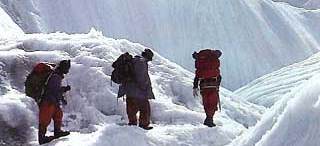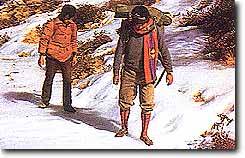India > Trekking > Darjeeling and Sikkim
Darjeeling and Sikkim
Perched at 2134 m directly opposite the Kanchenjunga, the Darjeeling hills at 8586 m, is the world's third highest mountain and India's tallest. The road rises steadily to Kurseong where wisps of cool air affirm an undeniably Himalayan setting. Road and train track follow each other for the remaining 60 km past the Jorebangla crossing and the Batasia loop to the bustling railway terminus. The earliest Everest expeditions started their journey from Darjeeling. A profusion of alpine blossoms and orchids can be found on the leisurely trips to the neighbouring lakes at Senchal and Mirik and the Lebong racecourse, which is the highest in the world.
This was also the home of the late Tenzing Norway and has since 1954 housed the Himalayan Mountaineering Institute where he trained a generation of mountaineers. The sunrise over Kanchenjunga as seen from Tiger Hill nearby, is also a great draw. On clear days, Everest is visible as well.
Down to the Teesta and up on the other side is Kalimpong, 67 km away and the main stopover point on the proposed trade route to Lhasa. Along the river, the road ascends once again to Gangtok, 88 km away coursing some very fine water runs. The direct road to Bagdogra is 125 km.
Trekkers to Darjeeling cannot resist a stopover in Sikkim. As in other parts of the Himalayas, the scale of its altitude and the distinct character of its seasons make Sikkim an all-year destination. Low altitude treks in winter and higher level excursions in spring, summer and autumn, when the snow line recedes, are possible. The conventional trekking periods are March - May before the monsoon, and after the rains in late September-mid-December.
For foreigners, travel formalities have now been further simplified. For sightseeing and trekking, and for visits to Gangtok, Rumtek, Phodong and Pemayangtse monasteries, permits can be obtained for periods upto 15 days from a number of designated offices including Indian missions overseas, immigration officers at the main metro airports, Bagdogra, Gangtok and other convenient points including the Sikkim tourism office in Delhi. Likewise, for trekking in the currently permitted Dzongri area of west Sikkim groups of 4-20 persons may obtain 15 day permits.

Indian nationals can visit the areas inside the inner line with permits which can be obtained in advance. Each season in Sikkim is distinct. The periods for outdoor excursions are several. March to May is the best season for flowers. Then on till September, the monsoon moves in with thick mists and heavy rain. The onset of autumn imparts an enduring clarity to the distant views until late December, when snow starts falling in the upper valleys. Meanwhile, the life cycle carries on, adapting to the changing colors of the landscape. In many ways, this deep seated harmony with nature is a special characteristic of Sikkim going back to the origin of its earliest inhabitants, the Lepchas. In its monasteries, picturesquely dotted across the state, lie the religious and cultural strengths of the friendly Sikkimese.
Getting there
The nearest airstrip to Darjeeling and Sikkim is Bagdogra in North Bengal. Bagdogra is 124 km and a 5 hour drive from Gangtok. Flights from Kolkata, Delhi and the north east connect this sector. The nearest railhead is Siliguri - 114 km and New Jalpaiguri - 125 km connecting Kolkata, Delhi, Guwahati and other important cities in India, to Sikkim and Darjeeling.
Gangtok is connected by road to Darjeeling Kalimpong and Siliguri. These places are well connected with other destinations in India.
Trekking routes
Treks in the Darjeeling area join up with the feeder Sikkim valleys of the Rangit river adjoining the Singalia ridge. Kanchenjunga is the prominent feature, its subsidiary peaks spread alongside with distant Everest also in view. Medium or strenuous grade trekking trips can be undertaken using Darjeeling as a convenient departure point.
Best Season
The most rewarding season for travelling through Darjeeling and Sikkim is between May to October. The winters are very cold and the region is swamped by fog. The rainy season make trekking unsafe. Plan your trip well in advance and enquire about the weather conditions before setting out.
The monsoon in the Teesta valley is heavy, lasting from early June till mid September for Sikkim and Darjeeling. For this reason, winter treks are recommended, beginning with October though the period from April to end May is also preferred.
Tiger Hill
Tiger Hill is the highest point in the area which provides the most exotic view of the Kanchenjunga peaks. From this place the other peaks of the Eastern Himalayas can be seen. On a clear day, the sight of Mt. Everest is enthralling. The sight of the sun rising from over the Tiger Hills is an unforgettable experience. The first rays of the sun on these peaks of the Great Barriers gives an impression of molten gold having been spread. Every day, a large number of people flock to this place to catch a glimpse of sunrise.The ideal way to enjoy the sunrise is over a cup of steaming coffee. There is also a watch tower which can be accessed by paying the tickets. The Tiger Hill can be reached by jeep, but if you want you can trek to the top. It is advisable to take a jeep to the top of the hills and return on foot. The return journey is a pleasant two hour walk and the scenery, full of little mountain streams and flowers, is breathtaking to say the least.
Darjeeling-Batasi-Tonglu-Sandakphu
This is a 6-7 day moderate trek from Maneshanjang which is 26 km by road from Darjeeling. Ideal for views along a standard trail. The route is famed for its view of Kanchenjunga, Mt. Everest and rhododendrons from Phalut and Sandakphu.
Darjeeling / Gangtok - Pemayangtse - Yoksam - Dzongri

6 days exhilarating trek with exclusive views of the brilliant Dzongri sunset over Kanchenjunga.
A trip to Sikkim is unthinkable without trekking among its challenging foothills. Previously trekking was not allowed, but to develop tourism and encourage tourist inflow, the government has started encouraging trekkers to scale the mountainous terrains of Sikkim. Trekking is allowed upto Dzongri for 10 days so long as you are accompanied by a travel agent recognized by the Indian Tourist Development Corporation and a liaison officer or guide provided by the Government of Sikkim. Trekking gears can be hired at Gangtok. The well known trekking routes are Nayan Bazar-Pemayangtse-Yaksum-Dzongri or Rangpo-Gangtok-Yaksum-Dzongri. More information on the trekking routes can be obtained from the tourist information office in Sikkim.

